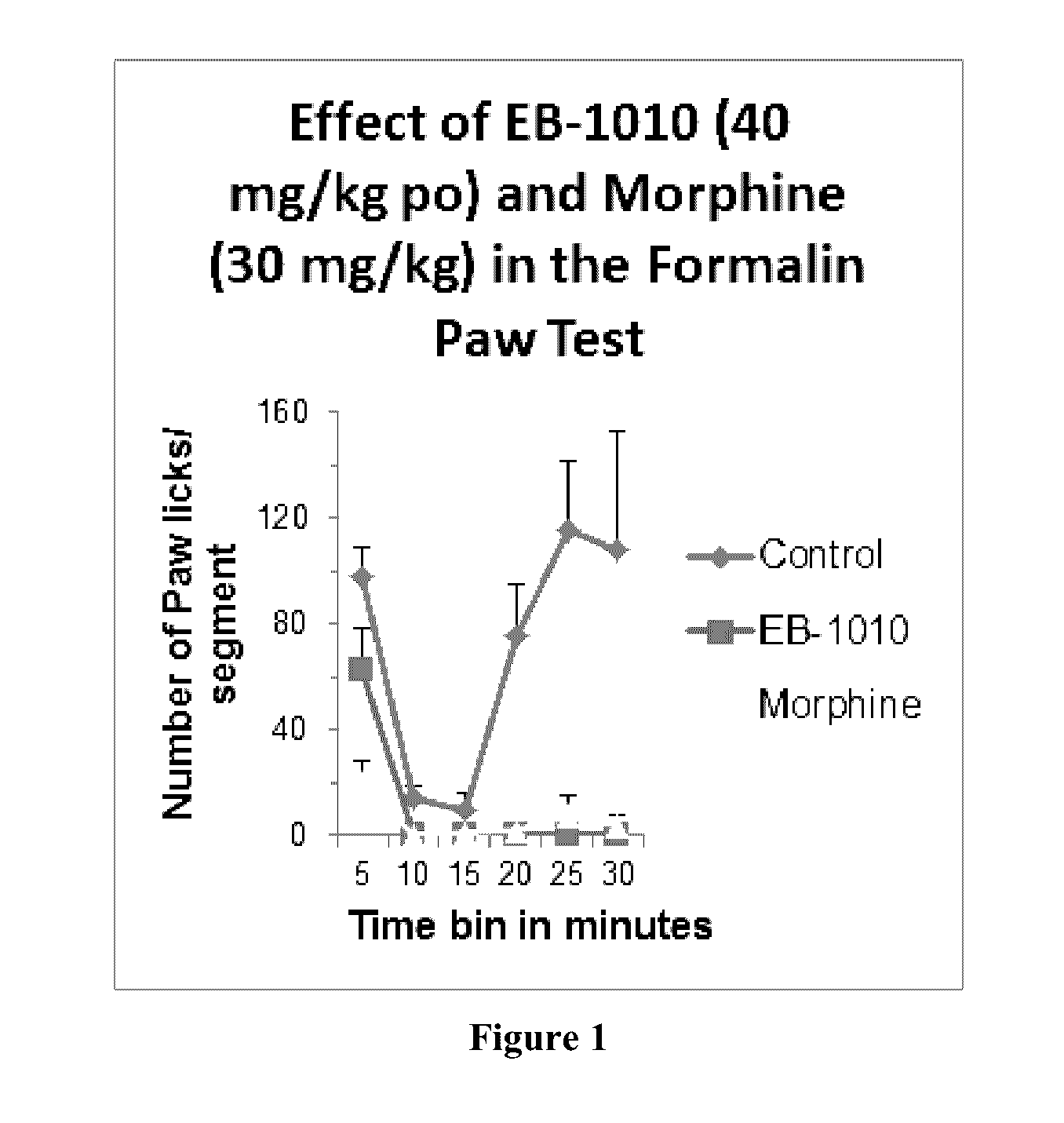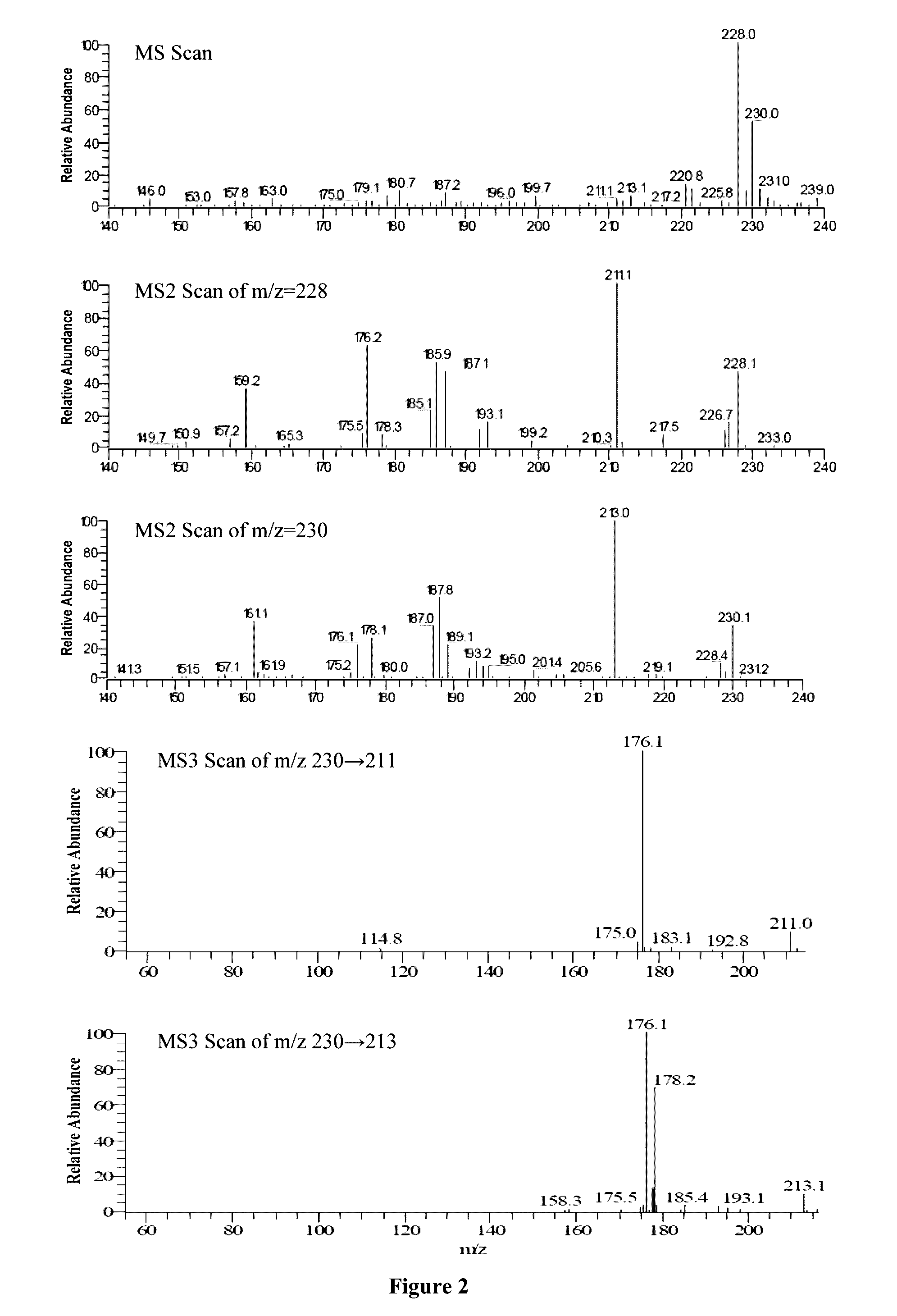Combinations and methods
a technology of combinatorial and method, applied in the field of new drugs, can solve the problems of inability or less able to maintain an independent lifestyle, hexane, disadvantage to patients, rendering racemic drugs inherently inefficient,
- Summary
- Abstract
- Description
- Claims
- Application Information
AI Technical Summary
Benefits of technology
Problems solved by technology
Method used
Image
Examples
example 1
Formalin Paw Test
[0260]Male CD-1 (Crl.) mice weighing 24±2 g from BioLasco Taiwan (under Charles River Laboratories Technology licensee) are used. All animals are maintained in a controlled temperature (22° C.-24° C.) and humidity (60%-70%) environment with 12 hours light / dark cycles for at least one week in MDS Pharma Services—Taiwan Laboratory prior to being used. Free access to standard lab chow (MF-18 (Oriental Yeast Co., Ltd. Japan)) and RO water is granted. All aspects of this work including housing, experimentation and disposal of animals are performed in general accordance with the Guide for the Care and Use of Laboratory Animals (National Academy Press, Washington, D.C., 1996).
[0261]The mice are divided into three groups and given vehicle (2% Tween 80), 40 mg / kg of (1R,5S)-(+)-1-(3,4-dichlorophenyl)-3-azabicyclo[3.1.0]hexane hydrochloride (EB-1010) or 30 mg / kg of morphine orally 1 hour before subplantar injection of formalin (0.02 ml, 5% solution). The amount of paw licking...
example 2
[0264]Human plasma protein binding of amitifadine ((1R,5S)-(+)-1-(3,4-dichlorophenyl)-3-azabicyclo[3.1.0]hexane hydrochloride) is determined by ADMETRx (Kalamazoo, Mich.) using an ultrafiltration technique. The samples containing various concentration of the test compound in DMSO are diluted into human plasma (Innovative Research, Inc., Novi, Mich.) to yield 1 or 10 μM final solute concentration. Samples of test drug in triplicate are mixed and incubated in Millipore Multiscreen filter plates with Ultracel-10 regenerated cellulose membranes for 60 minutes at 37° C. Following incubation, samples undergo centrifugation for 60 minutes at 2000×g and the filtrate is collected. Percent protein bound is determined from the concentration of free compound present in the filtrate following comparison to a standard curve of test drug. Aliquots of the filtrate are analyzed on the Waters Alliance 2795 HPLC utilizing a 3.5 μm Agilent ZORBAX Eclipse XBD-C18 50×2.1 column coup...
example 3
Caco-2 Bi-Directional Permeability Assay
[0267]The Caco-2 permeability of amitifadine is conducted by ADMETRx (Kalamazoo, Mich.). Aliquots of DMSO stock solution of drug are dissolved in Hanks Balanced Salt Solution containing 25 mM HEPES, pH 7.4 buffer with 0.05% polysorbate 80 to give target stock drug concentrations of 250 μM and 2.5% DMSO. Caco-2 cells are obtained from American Type Culture Collection (ATCC, Manassas, Va.) and are grown to confluence for 14-21 days on 1 μm filters in 24 well plates. Aliquots of drug are diluted in buffer to give 10 μM final concentration and 2, relative humidity of 95%, and temperature of 37° C. Receiver solutions consist of buffer only. Sequential samples of transported solute are taken at 20 minute intervals in duplicate over 2 hours and the concentration of the transported compound is determined by HPLC-UV / MS. Test sample concentration is determined by LC / MS. Permeability coefficients are calculated for each sampling interval, and averages fr...
PUM
| Property | Measurement | Unit |
|---|---|---|
| temperature | aaaaa | aaaaa |
| temperature | aaaaa | aaaaa |
| flow rate | aaaaa | aaaaa |
Abstract
Description
Claims
Application Information
 Login to View More
Login to View More - R&D
- Intellectual Property
- Life Sciences
- Materials
- Tech Scout
- Unparalleled Data Quality
- Higher Quality Content
- 60% Fewer Hallucinations
Browse by: Latest US Patents, China's latest patents, Technical Efficacy Thesaurus, Application Domain, Technology Topic, Popular Technical Reports.
© 2025 PatSnap. All rights reserved.Legal|Privacy policy|Modern Slavery Act Transparency Statement|Sitemap|About US| Contact US: help@patsnap.com



